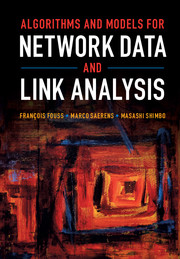Book contents
- Frontmatter
- Contents
- List of Algorithms
- List of Symbols and Notation
- Preface
- 1 Preliminaries and Notation
- 2 Similarity/Proximity Measures between Nodes
- 3 Families of Dissimilarity between Nodes
- 4 Centrality Measures on Nodes and Edges
- 5 Identifying Prestigious Nodes
- 6 Labeling Nodes: Within-Network Classification
- 7 Clustering Nodes
- 8 Finding Dense Regions
- 9 Bipartite Graph Analysis
- 10 Graph Embedding
- Bibliography
- Index
Preface
Published online by Cambridge University Press: 05 July 2016
- Frontmatter
- Contents
- List of Algorithms
- List of Symbols and Notation
- Preface
- 1 Preliminaries and Notation
- 2 Similarity/Proximity Measures between Nodes
- 3 Families of Dissimilarity between Nodes
- 4 Centrality Measures on Nodes and Edges
- 5 Identifying Prestigious Nodes
- 6 Labeling Nodes: Within-Network Classification
- 7 Clustering Nodes
- 8 Finding Dense Regions
- 9 Bipartite Graph Analysis
- 10 Graph Embedding
- Bibliography
- Index
Summary
The network science field. Since the start of the twenty-first century, network science, the field whose main goal is to analyze network data, has become more and more popular in various areas of science and technology [47]. This interest has grown in parallel with the popularity of large networks, especially online networks like theWorld Wide Web, where each node is a web page and hyperlinks can be viewed as edges linking the pages. Another obvious example is online social networks like Facebook, where nodes are persons and links are friendship relations.
Although networks have been studied for years in the fields of social network analysis, operations research, graph theory, and graph algorithmics, the wide availability of such network structures on the Internet clearly boosted the field in the late 1990s. Computer scientists, physicists, chemists, economists, statisticians, and applied mathematicians all started to analyze network data.
In computer science, the field was called link analysis, while in physics, it was more often known as network science, a term that is now used across most disciplines. Roughly speaking, link analysis and network science aim at analyzing and extracting information from complex relational data (observed relations between entities like people, web pages, etc.) and is considered, in physics, to be a subfield of complex systems. The book is dedicated to this subject.
Intended audience. We have written this book for upper-level undergraduate or graduate students, researchers, and practitioners involved, or simply interested, in network data analysis. The book is not, however, intended as an introduction to network science. We assume that the reader has already followed an introductory course on graphs and networks (e.g., [47, 258, 468, 522, 608, 781] or the chapters dedicated to network data in [836]) as well as elementary courses in computer science, probability, statistics, and matrix theory. We nevertheless start with an introductory chapter, “Preliminaries and Notation,” summarizing the necessary slightly more advanced material and the notation.
While the material of the book is oriented toward computer scientists and engineers, we think that it should also attract students, researchers, and practitioners in other fields having an interest in network science. The material can easily be followed by other scientists in many application areas, provided they have the basic background knowledge outlined previously.
Information
- Type
- Chapter
- Information
- Algorithms and Models for Network Data and Link Analysis , pp. xxiii - xxviPublisher: Cambridge University PressPrint publication year: 2016
